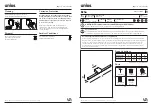
1
2
1.4.5 Stimulation should not be applied over swollen, infected, or inflamed areas or skin eruptions, e.g., phlebitis,
thrombophlebitis, varicose veins, etc.
1.4.6 Stimulation should not be applied over, or in proximity to, cancerous lesions.
1.4.7 For external use only.
1.4.8 Do not use IFC on the eye area.
1.4.9 This device should be used only under the continued supervision of a licensed medical practitioner.
1.4.10 Safety of IFC devices for use during pregnancy or delivery has not been established.
1.4.11 Electronic equipment such as ECG monitors and ECG alarms may not operate properly when IFC is in use.
1.4.12 Apply the electrodes to clean, dry, and unbroken skin only.
1.4.13 This device should not be used while driving, operating machinery, or during any activity in which
involuntary muscle contractions may put the user at undue risk of injury.
1.4.14 This device should be kept out of the reach of children.
1.4.15 Keep electrodes separate during treatment. Electrodes in contact with each other could result in improper
stimulation or skin burns.
1.5 Precautions:
1.5.1 Caution should be used for patients with suspected or diagnosed heart problems.
1.5.2 Caution should be used for patients with suspected or diagnosed epilepsy.
1.1 General information:
This interferential (IFC) device is a lightweight and portable medical device which can help to reduce pain and
discomfort. It utilizes the low electric-current to stimulate muscle nerves to achieve the symptomatic relief of
chronic intractable pain, post-traumatic pain, and post-surgical pain.
1.2 Cautions
Federal law (USA) restricts this device to sale by or on the order of practitioners licensed by the State in which they
practice to use or order the use of the device.
1.3 Indications for use:
This device is used in symptomatic relief of chronic intractable pain, post-traumatic and post-surgical pain.
1.4 Warnings:
1.4.1 The long-term effects of chronic electrical stimulation are unknown.
1.4.2 Stimulation should not be applied over the carotid sinus nerves, particularly in patients with a known
sensitivity to the carotid sinus reflex.
1.4.3 Stimulation should not be applied over the neck or mouth. Severe spasm of the laryngeal and pharyngeal
muscles may occur and the contractions may be strong enough to close the airway or cause difficulty in
breathing.
1.4.4 Stimulation should not be applied transthoracically in that the introduction of electrical current into the
heart may cause cardiac arrhythmias.
1. INTRODUCTION





































